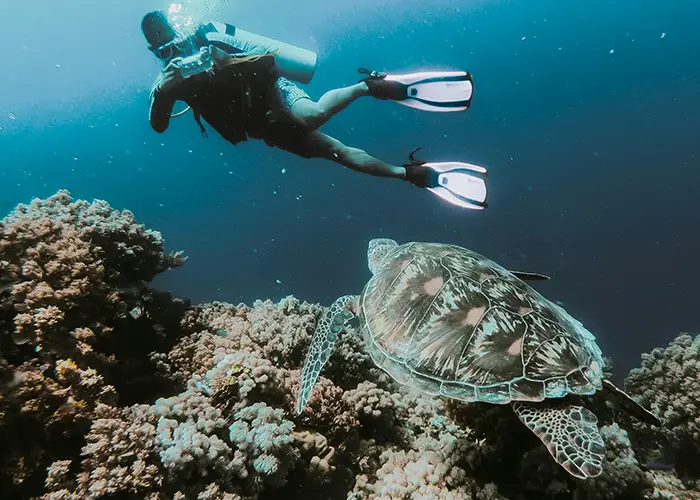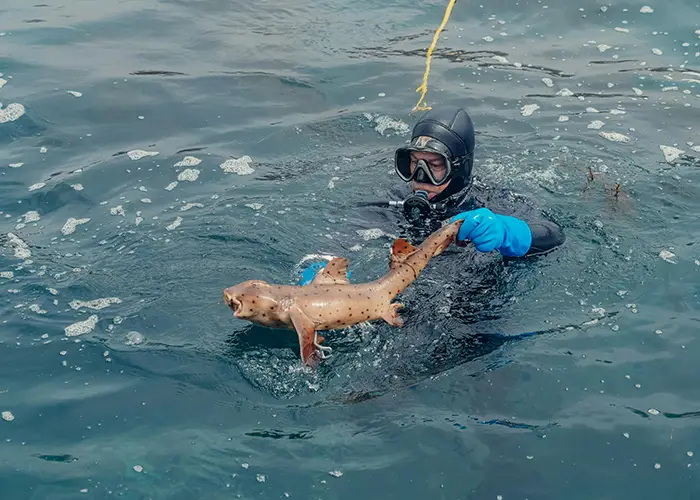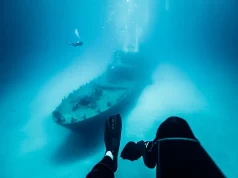
Whilst most divers dream of the Maldives or Great Barrier Reef, the world’s most extraordinary underwater experiences often lurk in unexpected corners of our oceans. From pristine coral gardens teeming with life to haunting shipwrecks frozen in time, the best diving spots in the world offer experiences that transcend typical tourist diving.
This comprehensive guide reveals 20 exceptional diving locations organized by the unique underwater experiences they offer, complete with practical planning details including certification requirements, seasonal timing, and insider tips to avoid the crowds. Rather than simply listing destinations by geography, we’ve categorized these world-class diving locations by what makes each one special beneath the surface.
You’ll discover shipwreck paradises where history comes alive, pristine coral gardens that rival any aquarium, and marine megafauna hotspots where encounters with sharks, rays, and whales create memories that last a lifetime.
World-Class Shipwreck Diving Destinations
For wreck diving enthusiasts, certain destinations stand out as underwater museums where maritime history meets incredible marine life. If you struggle with vision problems while diving, consider using prescription lenses in a scuba mask to enjoy crystal-clear views of these underwater wonders. These top diving destinations offer everything from intact warships to merchant vessels that have transformed into thriving artificial reefs.
Truk Lagoon, Micronesia – The Underwater Museum
Truk Lagoon represents the holy grail of shipwreck diving, home to over 60 Japanese warships and merchant vessels sunk during World War II’s Operation Hailstone in February 1944. The Fujikawa Maru stands out as the crown jewel, sitting upright in 37 meters of water with its aircraft cargo still visible in the holds.
Advanced Open Water certification is the minimum recommended, though many sites require deep specialty training. Best visited: April through November for optimal visibility and calm conditions. Water temperatures remain around 29°C year-round.
The lagoon’s protected waters have created perfect preservation conditions, with ships’ structures remaining largely intact after eight decades underwater. Swimming through cargo holds filled with Zero fighter aircraft parts creates an eerily beautiful experience that connects divers directly to history.
Scapa Flow, Scotland – Historic Naval Cemetery

Scotland’s Scapa Flow offers wreck diving in the cold, nutrient-rich waters of the North Atlantic. This natural harbor became the final resting place of the German High Seas Fleet, scuttled on 21st June 1919. The German battleship König sits in 37 meters of water, its massive gun turrets creating dramatic silhouettes against the surface light.
Cold water diving skills are essential—7mm wetsuits minimum, though most divers prefer drysuits. The marine life includes massive lobsters, colorful anemones, and schools of fish that use the wrecks as shelter.
The historical significance, combined with exceptional marine growth, makes each dive feel like exploring a living museum. The clear, cold waters provide excellent visibility, often exceeding 20 meters during the summer months.
SS Thistlegorm, Red Sea, Egypt
The SS Thistlegorm combines the best of wreck diving with the Red Sea’s incredible visibility and marine life. This British merchant vessel sits upright in 30 meters of water with perfectly preserved cargo: motorcycles, trucks, and military supplies exactly as loaded over 80 years ago.
The wreck attracts massive schools of barracuda, tuna, and jackfish, whilst coral growth has transformed the superstructure into a vibrant artificial reef. Advanced Open Water divers can explore the cargo holds safely, discovering Wellington boots still in their boxes and steam locomotives destined for the war effort.
USAT Liberty, Bali, Indonesia
The USAT Liberty in Tulamben represents one of the world’s most accessible world-class wrecks, sitting just 30 meters from shore in 9 meters of water. Open Water divers can explore the shallow sections, whilst the wreck extends to 37 meters for advanced exploration.
The Liberty’s popularity stems from its incredible macro life, from tiny nudibranchs to hunting cuttlefish. Night diving reveals a completely different ecosystem with flashlight fish and Spanish dancers creating an underwater light show.
Pristine Coral Gardens and Wall Diving
The world’s healthiest coral reef systems offer diving experiences that showcase marine biodiversity at its finest. These destinations prove that healthy reefs remain some of our planet’s most spectacular natural wonders.
Raja Ampat, Indonesia – Marine Biodiversity Capital
Raja Ampat sits at the heart of the Coral Triangle and hosts the highest marine biodiversity on Earth. With over 1,500 fish species and 600 coral species documented, every dive reveals something extraordinary.
Cape Kri holds the world record for fish species counted in a single dive—374 species recorded by marine biologists in 2012¹. Melissa’s Garden showcases soft coral diversity that resembles an underwater flower garden, whilst manta rays frequent cleaning stations at Arborek Jetty.
Optimal timing: October through April offers the best visibility and calmest seas. Liveaboard trips provide access to the most remote and pristine sites where coral coverage often exceeds 90%.
The diversity extends beyond fish to include walking sharks, giant clams, and coral formations that create underwater cathedrals. Each dive site offers distinctly different ecosystems within swimming distance of each other.
Red Sea, Egypt – Vibrant Coral Walls
Egypt’s Red Sea corridor offers some of the world’s most accessible world-class wall diving, with dramatic coral formations and exceptional visibility often exceeding 30 meters.
Brothers Islands, accessible only by liveaboard, feature dramatic walls covered in soft corals and patrolled by grey reef sharks and hammerheads. Elphinstone Reef offers the Red Sea’s most reliable shark encounters with oceanic whitetips cruising the blue water beyond the reef wall.
Dahab’s Blue Hole provides accessible shore diving with dramatic wall formations dropping into the abyss. Shore diving from Marsa Alam provides budget-conscious access to pristine reefs with dugongs, dolphins, and turtle encounters.
Palau – Jellyfish Lakes and Blue Corners

Palau combines unique geological formations with world-class shark diving. The famous Blue Corner offers the quintessential drift dive experience—hooking into the reef whilst grey reef sharks and barracuda create a living wall of marine life in the current.
German Channel offers predictable manta ray encounters at cleaning stations where these gentle giants glide overhead for minutes at a time. Jellyfish Lake provides a surreal snorkeling experience amongst millions of harmless jellyfish that have evolved without stingers.
Most sites require Advanced Open Water certification due to current conditions, but the reward is diving amongst some of the Pacific’s healthiest marine ecosystems.
Maldives – Atoll Pass Diving
The Maldives transforms from a luxury resort destination to a serious diving paradise in the deep channels between atolls. Manta Point at Baa Atoll offers reliable manta ray encounters with UNESCO Biosphere Reserve protection, ensuring healthy populations.
Banana Reef showcases classic Maldivian diving with dramatic overhangs and caves where nurse sharks rest during daylight hours. Channel diving at Fotteyo Kandu offers adrenaline-pumping drift dives through narrow passes where sharks and rays concentrate to feed in the current.
The combination of luxury accommodation and world-class diving makes the Maldives perfect for non-diving partners, whilst serious divers explore some of the Indian Ocean’s most pristine reefs.
Marine Megafauna Encounters
Some diving destinations stand out for their incredible encounters with large marine animals, creating experiences that transform divers into lifelong ocean advocates.
Galápagos Islands – Hammerhead Capital
The Galápagos Islands offer diving experiences found nowhere else on Earth. Wolf Island and Darwin’s Arch represent the ultimate diving pilgrimage for advanced divers seeking encounters with marine megafauna.
Wolf Island’s towering seamount attracts massive schools of scalloped hammerhead sharks, often numbering in the hundreds, from July through December. Darwin’s Arch hosts enormous schools of hammerheads alongside Galápagos sharks and occasional whale sharks reaching lengths of 12 meters.
Strong currents and 24+ meter depths require Advanced Open Water certification minimum, with deep diving and drift diving specialties strongly recommended. Liveaboard trips are essential for accessing the best sites, with 7-day itineraries providing multiple opportunities for big animal encounters.
South Africa – Great White Shark Capital
Gansbaai, South Africa, offers the world’s most reliable great white shark encounters through cage diving experiences. Dyer Island creates perfect hunting conditions with a resident seal colony that attracts great whites year-round.
The famous Sardine Run from May through July represents one of the ocean’s greatest spectacles, as millions of sardines migrate northward, pursued by dolphins, sharks, whales, and thousands of seabirds, creating feeding frenzies visible from the surface.
Water temperatures require 7mm wetsuits minimum, but the adrenaline rush of facing apex predators face-to-face creates memories that last forever.
Fiji – Soft Coral Capital and Shark Encounters
Fiji’s Beqa Lagoon has become renowned for bull shark diving experiences where divers kneel on sandy bottoms whilst bull sharks cruise overhead during controlled feeding dives. Rainbow Reef showcases Fiji’s legendary soft corals with underwater gardens creating some of the world’s most colorful diving.
Bligh Water offers pelagic encounters with manta rays, whale sharks, and seasonal humpback whale sightings from July through October when whales migrate through Fijian waters to calving grounds.
The combination of dramatic topography and healthy fish populations makes every dive in Fiji feel like swimming through a living aquarium.
Mexico – Whale Shark and Cave Diving Paradise

Isla Mujeres offers seasonal whale shark encounters from June through September when these gentle giants congregate to feed on plankton blooms. Swimming alongside 9+ meter whale sharks represents a bucket-list experience requiring only basic swimming skills and snorkeling equipment.
The Cenotes of the Yucatan Peninsula provide unique freshwater cave diving experiences. Cenote Dos Ojos and Gran Cenote offer cavern diving suitable for Open Water divers, with crystal-clear water and dramatic rock formations creating cathedral-like spaces.
The Socorro Islands offer encounters with giant Pacific manta rays, whale sharks, and playful dolphins in the remote Pacific, accessible only by liveaboard expeditions departing from Cabo San Lucas.
Australia – Great Barrier Reef and Beyond
The Great Barrier Reef remains iconic, with Cod Hole offering potato cod encounters where these massive fish approach divers like underwater puppies. Ribbon Reefs provide pristine coral diving with sites like Steve’s Bommie showcasing healthy hard coral formations.
Ningaloo Reef in Western Australia offers whale shark encounters and pristine coral systems without the crowds of the east coast. The reef’s proximity to shore makes it accessible for budget-conscious travelers.
Philippines – Diverse Marine Ecosystems
Apo Island showcases successful marine protection with vibrant reefs and turtle encounters on every dive. Bohol offers unique tarsier wildlife above water and excellent diving below, including the famous Balicasag Island wall diving.
Palawan combines stunning landscapes with world-class diving, from the wrecks of Coron to the pristine reefs of El Nido and the biodiversity hotspots around Tubbataha Reefs Natural Park.
Thailand – Tropical Paradise Diving
Similan Islands offer granite boulder formations, creating unique topography with swim-throughs and diverse marine life. Richelieu Rock provides some of Thailand’s best diving with whale shark encounters and incredible fish diversity, including schools of barracuda and trevally.
Koh Tao remains one of the world’s most affordable places to learn diving, whilst offering legitimate world-class sites like Sail Rock with its famous chimney swim-through.
Honduras – Caribbean Wall Diving
Roatán offers affordable Caribbean diving with pristine walls and diverse marine life, including healthy populations of grouper and snappers. The Mesoamerican Reef provides extensive wall diving opportunities with sites accessible directly from shore.
Utila offers budget diving with reliable whale shark encounters, making it popular with backpackers and serious marine life enthusiasts alike.
Micronesia – Remote Pacific Paradise
Beyond Truk Lagoon, Yap offers manta ray encounters at cleaning stations where these graceful giants arrive like clockwork for cleaning services. Pohnpei provides excellent wall diving and World War II wrecks in uncrowded conditions.
These remote destinations reward the effort required to reach them with pristine conditions and unique marine life encounters found nowhere else.
Planning Your Diving Adventures
Successfully experiencing these extraordinary destinations requires careful planning beyond simply booking flights and accommodation.
- Certification Considerations: Most destinations require Advanced Open Water certification minimum, with many sites benefiting from specialty training in deep diving, drift diving, or wreck penetration. Consider completing specialties before travelling to maximize your underwater time.
- Seasonal Timing: Research local weather patterns, marine life migrations, and visibility conditions. Many destinations have distinct seasons that dramatically affect diving conditions—visiting during optimal periods can mean the difference between good diving and life-changing experiences.
- Operator Selection: Choose reputable local operators with strong safety records and environmental practices. Verify certifications and equipment standards before booking. Reading recent reviews from certified divers provides insight into current conditions and operator quality.
- Equipment Considerations: Many remote destinations have limited equipment availability or quality concerns. Bringing your own mask, fins, and exposure protection ensures comfort and safety whilst supporting your travel investment.
- Health and Safety: Ensure your diving insurance covers remote locations and emergency evacuation. Many destinations require significant travel time to reach hyperbaric chambers, making conservative diving practices essential.
Conclusion
These 20 extraordinary diving destinations represent the pinnacle of underwater experiences, each offering unique encounters that will transform your relationship with the ocean’s incredible diversity. From haunting shipwrecks where history comes alive to pristine coral gardens showcasing nature’s artistry, these locations demonstrate why diving becomes a lifelong passion for millions worldwide.
The key to maximizing these adventures lies in matching destinations to your certification level, personal interests, and diving goals. Whether drawn to pristine coral gardens, historic shipwrecks, or heart-pounding encounters with marine megafauna, each destination rewards careful planning with unforgettable memories that will inspire decades of diving adventures. You can also dive into the ultimate scuba adventures to explore more insights and inspiration for your next underwater journey.
Remember that the world’s oceans are changing rapidly due to climate change and human impact. These extraordinary diving destinations represent precious windows into marine ecosystems requiring our protection and respect. By choosing responsible operators and supporting marine conservation efforts, we ensure these incredible experiences remain available for future generations of divers to discover and protect.
Start planning your next diving adventure by researching specific operators, seasonal conditions, and certification requirements for your chosen destination. The world’s best diving spots await those prepared to venture beyond the ordinary and discover what makes our oceans truly extraordinary. Each dive brings discoveries, new perspectives, and a deeper appreciation for the underwater world that covers over 70% of our planet, yet remains largely unexplored.





